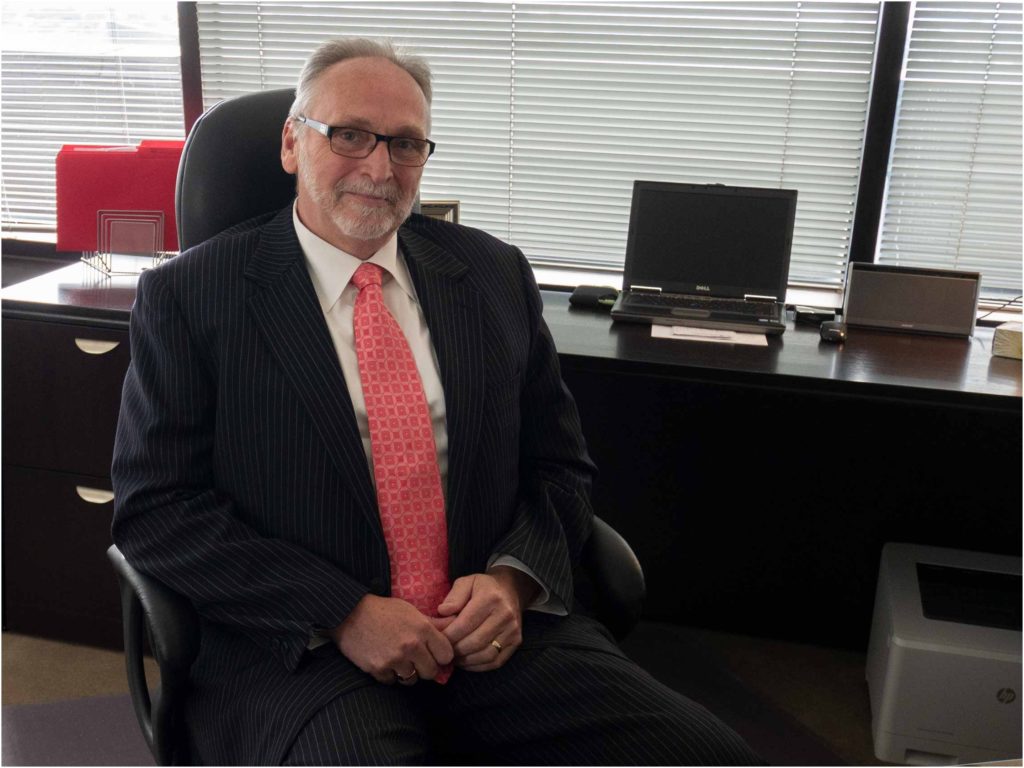
Whether or not Canada bans Huawei, Innovation, Science and Economic Development (ISED) Minister Navdeep Bains says the federal government will prioritize protecting Canada’s national security interests while it works with Bell, Telus and the rest of the country’s carriers on 5G proliferation.
“We have an open door policy, we work closely with the carriers. They know what our priorities are,” Bains said during a January 31st sit down interview with MobileSyrup in West Block on Parliament Hill.
Bains added that the government’s objective is clear and focused: to protect the safety and security of Canadians.
Canada’s relationship with China has soured since the beginning of December when Canadian authorities arrested Huawei’s CFO Meng Wanzhou in Vancouver. Meng, who is also the daughter of Huawei president and founder Ren Zhengfei, was arrested on fraud-related charges.
The U.S. laid 13 charges of bank and wire fraud against Meng, Huawei and its subsidiary Skycom. She currently faces extradition to the U.S.
Canadian national carriers Bell and Telus have invested millions of dollars to prepare for their future 5G rollouts. If a ban is implemented by the federal government, they could stand to lose as much as $1 billion.
He said that his department has had “candid conversations” with the carriers and has been transparent on issues of “national security and technology deployment.”
“We have an open door policy, we work closely with the carriers. They know what our priorities are”
Bains added that the carriers have also been working with Public Safety Minister Ralph Goodale.
“[The carriers] have been speaking with [Goodale’s] team to express their points of view. Ultimately, different carriers have different levels of investments with different technologies. Some with Huawei and some not with Huawei,” said Bains. “That’s a decision they made. A business case decision they made quite some time ago and they recognize the pros and cons associated with that.”
Bains did not go into details regarding the ongoing reviews of Huawei by Goodale and his department. He did say that the government has been in conversation with Canada’s allies to understand what they’re doing and what their experiences have been.
Out a stated fear of cybersecurity attacks, the U.S. banned the company from providing 5G equipment in August 2018. Following the U.S., Australia and New Zealand banned the company, as well. The three countries are members of the Five Eyes intelligence-sharing alliance, as is Canada and the U.K.
Huawei Canada has had a presence in Canada since 2008. In that time, the company has partnered with 13 universities to conduct 5G research. Last month, Bell and Telus issued separate internal memos to their respective employees concerning the topic of Huawei. In its memo, Telus defended the use of the Chinese manufacturer’s networking equipment.
Canada’s relationship with 5G, then and now
Some industry analysts have claimed that the way in which Canada has dealt with Huawei has set the country back in becoming a leader in the technology’s deployment.
Bains disagreed with this statement, adding that Canada is well on its way to successfully deploying the technology and becoming a 5G powerhouse.
“We’re in the global race and we’re competing with other jurisdictions for 5G technology and 5G spectrum,” said Bains. “So that’s why we have a clear spectrum plan to make sure we are in the forefront or comparable to some of the other key nations that are deploying 5G.”
As an example, he noted that the government is working with Encqor, a Quebec and Ontario 5G research partnership alliance that includes Ciena, Thales, CGI, IBM and, perhaps most notably, Swedish telecommunications equipment manufacturer Ericsson.
In June 2018, Ericsson helped launch two 5G innovation hubs in Quebec City and Montreal.
Was Nokia partnership a way to ease Huawei fears?
On January 24th, Bains finalized a research partnership with Nokia in Davos, Switzerland during the World Economic Forum.
As part of the partnership, the federal government will invest $40 million into Nokia Canada.
Nokia, meanwhile, will help develop “cybersecurity tools to protect telecommunications networks and establish a new Nokia Bell Labs presence in Canada to conduct research to help telecommunications networks meet the needs of 5G technology.”
The partnership is also expected to create more than 200 jobs and support the 2,000 employees currently in Canada.
Bains did not specifically answer whether or not the announcement was made to alleviate fears Canadians may have surrounding Huawei.
However, he did state that Canada has been working on developing 5G technology “well before this issue with Huawei came into the public forefront.”
“We’re in the global race and we’re competing with other jurisdictions for 5G technology and 5G spectrum”
“We’ve been talking about our government’s commitment to making sure we play a leadership role on technology on the deployment of 5G,” he added.
Canada will let smaller players get spectrum in upcoming auctions
It is important to note that 5G devices will operate over traditional and new cell radio frequency bands that include the low- (sub-1GHz such as 700MHz), mid- (1.6GHz, around 3.5-3.8GHz), and millimetre-wave (mmWave, such as 28GHz) ranges.
And Canada, at this moment, doesn’t even have the spectrum needed to deploy the network.
Last June, Bains announced that the 3.5MHz spectrum auction is set for 2020, while a mmWave auction is set for 2021.
In the meantime, Bains’ department has set aside 43 percent of 600MHz spectrum for smaller regional players and newer wireless carriers. The auction is expected to take place in the spring.
It will be the first time the government has made way for smaller players, like Shaw, to participate in spectrum auctions and in the competitive market place.
“We looked at previous experiences, we looked at how auctions occurred in the past, how spectrum was allocated. We came to the conclusion that this set aside would promote more competition and create more opportunities for other players, like Shaw and others to really compete with others and we believe that competition will reduce prices and that’s really our end goal,” Bains said.
CRTC will make independent decisions, despite differences
For a while now, many in the telecommunications industry have not been happy with how Ian Scott, chairperson and CEO of the Canadian Radio-television and Telecommunications Commission (CRTC), has been making decisions.
In fact, when the CRTC announced its decision on the low-cost, data-only plans proposed by Canada’s Big Three carriers, which one advocacy group characterized as a“slap in the face,” Dwayne Winseck, director of the Canadian Media Concentration Research Project, said it was time to seriously consider removing Scott as chair of the CRTC.
Bains did not directly respond to the statement.
Instead, he said: “[The CRTC,] they’re independent in that regard. But we usually set policy objectives to demonstrate to them what our priorities are and we continue to remain engaged.”
He also reiterated again that he was disappointed with the CRTC’s Wi-Fi first MVNO decision that was made in 2017.
“With the MVNO decision, we were disappointed because we believe that technology is a clear way to help deal with affordability issues and provide meaningful solutions,” Bains said. “As I mentioned, we were disappointed.”
However, Bains said that his department remains engaged with Scott, and added that the chairperson “knows what our policies and priorities are.”
“He is engaged with my team. We respect his independence. We respect he has his own mandate, but we do engage. For example particularly when we rolled out the ‘Connect To Innovate’ program, we said this is how we are going to roll it out, this is the lessons we learned, things that went well and things that didn’t go well,” Bains said.
Stance on Net Neutrality
Despite the independence of the CRTC, Bains reiterated that his department remains steadfast on its stance on net neutrality.
Concerns about net neutrality continue to persist despite the CRTC’s decisions on proposals like FairPlay Canada and previous net neutrality decisions.
Bains said that through the remainder of his term, and as part of his 2019 election mandate, he expects net neutrality to become a “guiding principle as we move forward in the Broadcasting and Telecommunications Act review.”
Why split rural broadband from mandate so soon to the election
Before the start of the last Parliamentary session and seven months before the 2019 federal election, Prime Minister Justin Trudeau appointed Nova Scotia Member of Parliament Bernadette Jordan as the Rural Economic Development Minister.
As part of her mandate, she is charged with bringing high-speed internet to rural parts of Canada. The mandate was previously a part of Bains’ docket.
When asked what the rationale around splitting his mandate so soon into the next election means, Bains said that it wasn’t bad, in fact, it was done to further give importance to rural communities.
“Rural communities are essential both economically but politically and socially…”
“It’s to build momentum on our focus on rural communities and how important they are to our economic success,” Bains said, adding that moving into the election it was important to ensure that issues surrounding rural communities are properly addressed by a designated minister.
“Rural communities are essential both economically but politically and socially…Bernadette would complement the work I’m doing around the deployment…around high-speed internet connectivity in the rural communities,” Bains said.
Photography by Andrew Meade.
MobileSyrup may earn a commission from purchases made via our links, which helps fund the journalism we provide free on our website. These links do not influence our editorial content. Support us here.




